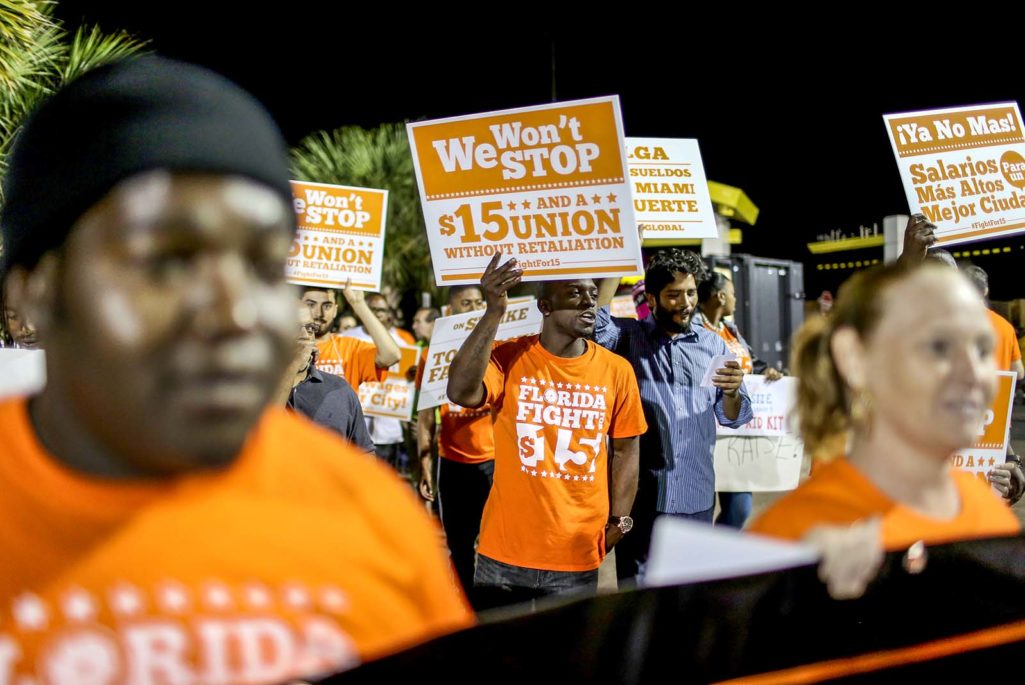Making the Rent: Back at Work, Still Out of Pocket

Protesters gather on tax day asking for higher wages on April 15, 2015 in Miami Gardens, Florida. Fast food workers in cities around the United States joined by adjunct professors, home care, child care, airport, industrial laundry and others were asking for higher wages and other rights for working people.
Photo: Joe Raedle/Getty Images
Although crisis-level unemployment has been stemmed, labor continue to struggle in efforts to recoup the ground lost in wages suffered during the global financial crisis.
According to a recent report on labor markets, 75 percent of OECD countries “still face either a sizeable unemployment gap (measured as 2 percentage points or more above the pre-crisis level) or a sizeable wage gap (average wages at least 5 percent below the crisis level) or both.”
Low investment, anemic productivity gains and weak job creation along with stagnant wages combine to form what the report calls “a low-growth trap” for labor markets. The report cites an “urgent need” for macroeconomic and structural policies to be brought to bear on the crisis.
The good news underlying the dismal wage picture is that, at least for the OECD area, “jobs recovery has been underway since the first quarter of 2010,” when the average employment rate reached its post-crisis trough of only 58.6 percent of the population employed, the report said, resulting in 20.3 million “missing jobs.”
Despite slow growth and a rash of economic headwinds, the jobs deficit shrank to 5.6 million by the of 2015, the report said. That gap is projected to finally close sometime next year, the report said. But averages have a way of burying more brutal truths: The hardest hit countries, such as Greece, Ireland and Spain, are still fighting a jobs gap that hovers near 10 percent. “While it is encouraging that employment is now rising quite rapidly in these hardest-hit countries, a full jobs recovery remains some way off and there is a risk that it will not be achieved before a new recession arrives,” the report said.
Given weak productivity growth, the report wonders “whether workers can ever recuperate the potential lost wage gain” since the crisis hit.
“The prospects for returning to vigorous wage gains (are) closely tied to whether the global economy manages to move from the current low growth equilibrium characterized by low investment, subpar productivity growth and historically weak international trade, which in turn calls for a comprehensive policy response, including more ambitious use of fiscal policy and additional structural reforms,” the report said.
A bright spot in the report is the fact that the number of long-term unemployed finally started falling during 2015, “suggesting that this group is beginning to share more of the benefits of the overall labor market recovery,” the report said. “However, it is far too early to declare victory,” the report said, adding, “Governments need to continue to assist this group, who are often shunned by employers, to move back into suitable jobs.”
Governments bear the brunt of jump-starting the process. The report notes that governments need to “redouble their efforts level the playing the field” for vulnerable groups, such as the long-term unemployed. One way governments can do so is by investing more in so-called “second chance” programs such as École de la Deuxième Chance in France or the Jobs Corps in the United States.
One of the key needs is to help women in the workforce “better reconcile their family responsibilities with employment.” The report cites subsidized childcare as a method that’s been proven effective “in enhancing women’s employment in several Latin American countries.”



